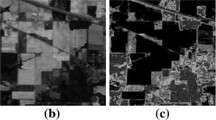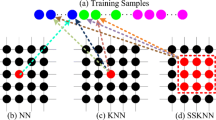Abstract
Recently, a general framework for spectral-spatial classification has caught the attention of the hyperspectral imagery (HSI) society. It consists of three parts: classification, segmentation and combination of the former results to make a refined labeled map. Seeing the potentials of the last part, we derive a novel combination rule based on affinity scoring (CRAS). The core of the system is affinity score (AS), which is derived from fuzzy logic. Every AS measures the degree, i.e., the affinity, by which a pixel belongs to a class. The score is essentially decided by three factors: local spatial consistency, spectral similarity, and prior knowledge. The method is compatible with basic classification and segmentation tools, thus saving the trouble of designing complex techniques for the other parts in the framework. Experimental results show that CRAS excels several basic techniques as well as various state-of-the-art methods in the area of spectral-spatial classification.
摘要
创新点
近年来, 空谱结合的高光谱图像分类方法受到重视。 在该领域内, 存在一种分类-分割-合并的框架。 为了提升该框架中合并环节的作用, 本文提出一种新型的基于隶属度评分的新的合并方法, 用于空谱结合的分类。 该算法的核心是隶属度评分, 其概念由模糊数学中的 “隶属度” 发展而来。 一个隶属度分数实际上衡量的是一个像素属于某一个类别的程度。 隶属度评分主要受到三个因素的影响: 局部空间一致性, 光谱相似性以及先验知识。 提出的合并算法可与基本的经典的分类和分割算法结合使用。 实验证明提出的合并算法在分类精度上优于多种不同的空谱结合的经典算法及以当前先进的空谱结合的算法。
Similar content being viewed by others
References
Fauvel M, Tarabalka Y, Benediktsson J A, et al. Advances in spectral-spatial classification of hyperspectral images. Proc IEEE, 2013, 101: 652–675
Camps-Valls G, Tuia D, Bruzzone L, et al. Advances in hyperspectral image classification. IEEE Signal Process Mag, 2014, 31: 45–54
Khodadadzadeh M, Li J, Plaza A, et al. Spectral-spatial classification of hyperspectral data using local and global probabilities for mixed pixel characterization. IEEE Trans Geosci Remote Sens, 2014, 52: 6298–6314
Pu H Y, Chen Z, Wang B, et al. A novel spatial-spectral similarity measure for dimensionality reduction and classification of hyperspectral imagery. IEEE Trans Geosci Remote Sens, 2014, 52: 7008–7022
Chen Y, Nasrabadi N, Tran T. Hyperspectral image classification via kernel sparse representation. IEEE Trans Geosci Remote Sens, 2013, 51: 217–231
Huang X, Zhang L P. An SVM ensemble approach combining spectral, structural, and semantic features for the classification of high-resolution remotely sensed imagery. IEEE Trans Geosci Remote Sens, 2013, 51: 257–271
Pesaresi M, Benediktsson J A. A new approach for the morphological segmentation of high-resolution satellite imagery. IEEE Trans Geosci Remote Sens, 2001, 39: 309–320
Fauvel M, Chanussot J, Benediktsson J A. A spatial-spectral kernel-based approach for the classification of remotesensing images. Patt Recogn, 2012, 45: 381–392
Achanta R, Shaji A, Smith K, et al. SLIC superpixels compared to state-of-the-art superpixel methods. IEEE Trans Patt Anal Mach Intell, 2012, 34: 2274–2280
Yang H, Du Q, Ma B. Decision fusion on supervised and unsupervised classifiers for hyperspectral imagery. IEEE Geosci Remote Sens Lett, 2010, 7: 875–879
Tarabalka Y, Benediktsson J A, Chanussot J, et al. Multiple spectral-spatial classification approach for hyperspectral data. IEEE Trans Geosci Remote Sens, 2010, 48: 4122–4132
Tilton J C, Tarabalka Y, Montesano P M, et al. Best merge region growing segmentation with integrated non-adjacent region object aggregation. IEEE Trans Geosci Remote Sens, 2012, 50: 4454–4467
Tarabalka Y, Chanussot J, Benediktsson J A. Segmentation and classification of hyperspectral images using minimum spanning forest grown from automatically selected markers. IEEE Trans Syst Man Cybern B-Cybern, 2010, 40: 1267–1279
Bernard K, Tarabalka Y, Angulo J, et al. Spectral-spatial classification of hyperspectral data based on a stochastic minimum spanning forest approach. IEEE Trans Image Process, 2012, 21: 2008–2021
Kang X, Li S, Benediktsson J A. Spectral-spatial hyperspectral image classification with edge-preserving filtering. IEEE Trans Geosci Remote Sens, 2014, 52: 2666–2677
Tilton J C. Image segmentation by region growing and spectral clustering with a natural convergence criterion. In: Proceedings of IEEE International Geoscience and Remote Sensing Symposium, Seattle, 1998. 4: 1766–1768
Beaulieu J M, Goldberg M. Hierarchy in picture segmentation: a stepwise optimization approach. IEEE Trans Patt Anal Mach Intell, 1989, 11: 150–163
Plaza A J, Tilton J C. Automated selection of results in hierarchical segmentations of remotely sensed hyperspectral images. In: Proceedings of IEEE International Geoscience and Remote Sensing Symposium, Seoul, 2005. 7: 4946–4949
Tarabalka Y, Tilton J C, Benediktsson J A, et al. Marker-based hierarchical segmentation and classification approach for hyperspectral imagery. In: Proceedings of International Conference Acoustics, Speech and Signal Processing (ICASSP), Prague, 2011. 1089–1092
Tarabalka Y, Tilton J C, Benediktsson J A, et al. A marker-based approach for the automated selection of a single segmentation from a hierarchical set of image segmentations. IEEE J Sel Top Appl Earth Observ Remote Sens, 2012, 5: 262–272
Widayati A, Verbist B, Meijerink A. Application of combined pixel-based and spatial-based approaches for improved mixed vegetation classification using IKONOS. In: Proceedings of 23rd Asian Conference on Remote Sensing, Kathmandu, 2002. 1–8
Briem G, Benediktsson J A, Sveinsson J R. Multiple classifiers applied to multisource remote sensing data. IEEE Trans Geosci Remote Sens, 2002, 40: 2291–2299
Kittler J, Hatef M, Duin R P W, et al. On combining classifiers. IEEE Trans Patt Anal Mach Intell, 1998, 20, 226–239
Liu B, Hu H, Wang H. Superpixel-based classification with an adaptive number of classes for polarimetric SAR images. IEEE Trans Geosci Remote Sens, 2013, 51: 907–924
Jung M, Henkel K, Herold M, et al. Exploiting synergies of global land cover products for carbon cycle modeling. Remot Sens Environ, 2006, 101: 534–553
Dópido I, Villa A, Plaza A, et al. A quantitative and comparative assessment of unmixing-based feature extraction techniques for hyperspectral image classification. IEEE J Sel Top Appl Earth Observ Remote Sens, 2012, 5: 421–435
Author information
Authors and Affiliations
Corresponding author
Rights and permissions
About this article
Cite this article
Chen, Z., Wang, B. Spectral-spatial classification for hyperspectral imagery: a novel combination method based on affinity scoring. Sci. China Inf. Sci. 59, 102313 (2016). https://doi.org/10.1007/s11432-016-5576-y
Received:
Accepted:
Published:
DOI: https://doi.org/10.1007/s11432-016-5576-y
Keywords
- hyperspectral imagery
- spectral-spatial classification
- affinity score
- local spatial consistency
- fuzzy
- superpixel




